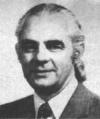
Dr. David R. Saunders, Professor of Psychology at the University of Colorado and later Dr. David R. Saunders is a Research Associate at the University of Chicago's Industrial Relations Center.
He became involved in the Colorado Project, the so-called independent civilian scientific research effort on UFO reports lead by Pr. Edward Condon, and thus known as the "Condon Report."
He thought that this effort would be an unbiased evaluation, but soon discovered an internal memo; which proved that the conclusion was already decided in the minds of Edward Condon and his project assistant Robert Low. Because he dared protest publicly on the bias of the latter and showed the internal memo to the press, he and Dr. Levine, co-discoverer of the infamous memo, were sacked under the motive of "incompetence." Subsequently, half of the members of the group resigned, as a protestation against the obvious bias of the project.
Soon after Saunders was fired from the "Condon" study group, he wrote a much ignored book, "UFOs? Yes! Where the Condon Committee Went Wrong", in which he detailed the reasons why Condon and Low decided to ignore legitimate UFO cases, and how their conclusion was formulated in advance in a biased manner. He also detailed why other scientists on the project determined that UFOs are likely to be vehicles from outer space, and how they were fired or their conclusion ignored.
As member of the "Condon" group, Dr. David Saunders had established the UFOCAT computer database of UFO reports, stored using a coding system he devised. He continued this work after the end of the Colorado Project with the help of the J. Allen Hynek Center for UFO Studies (CUFOS) until 1980. It had more than 106,000 entries. UFOCAT was not maintained during some ten years after 1980 but it has now been reactivated by Dr. Donald Johnson, a former associate of Dr. Saunders and CUFOS board member.
Before it was over I had worked out a comprehensive scheme of coding, and some 7,500 reports were processed - I was shooting for the 10,000 mark to provide a good basis for statistical analysis. However, even when we had only a few hundred reports coded and collated in the "Sighting Catalog" it was possible to see some interesting differences in the quality of reports arriving from different sources, and it was even more interesting to consider these in the light of the question network that might have been used to screen out fake UFOs.
For example, a very basic question is the duration of a sighting. Very brief sightings are apt to be meteors or jet aircraft, and even if they are UFOS, they are unlikely to contribute much information. Very extended sightings are most apt to be balloons (in the daytime) or astronomical objects (at night). Therefore, there is an optimal duration for a UFO sighting, about five to fifteen minutes - long enough to observe something worth reporting, but not too long. When I made distributions of the durations associated with Blue Book and NICAP reports, since these were then our only sources of routine "unselected" reports, I was struck by the difference in the distributions. Blue Book had a much higher proportion of extremely short durations and also a noticeably higher proportion of extremely long durations, suggesting that they were dealing with a potentially more explainable collection of reports. NICAP'S reports included a much higher proportion in the middle range of durations that would interest us. Had I then been in a position to make comparisons based on other relevant features of the reports - for example, reported colors, time of day, apparent size, number of details - I am sure similar patterns would have emerged.
What I did do next was to go through the computer listings to see what proportion of the current reports were coming to us by way of more than one channel The result of this exercise did much to explain the results of the previous one. The only sightings that we heard about from both Blue Book and NICAP were sightings that had achieved enough publicity for us to have heard about them also from still other sources - either press notices or telephone calls. Except for the overlap created by this relatively small number of notorious cases, the Blue Book and NICAP samples were completely different.
Extract from ""UFOs? Yes! Where the Condon Committee Went Wrong - The inside story by an ex-member of the official study group", book by Dr. David Saunders and R. Roger Harkins, World Publishing, New York, p. 119, 1969.